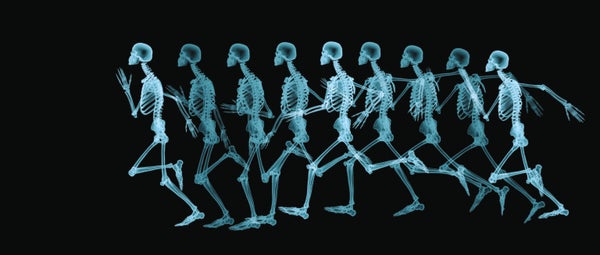In the face of fear, whether it be caused by a grizzly bear or an audience waiting to hear you speak, your body initiates a reaction to stress. The breath quickens, the pupils dilate, the heart begins to pound. These automatic responses occur as part of the so-called fight-or-flight response, the body’s evolved mechanism to deal with threats around us. Scientists have known for decades that this reaction is triggered by hormones released by the adrenal glands, two cone-shaped organs that sit atop the kidneys. Now a new hormone has entered the picture—osteocalcin, a protein produced and secreted by bone.
Gerard Karsenty, a physician and geneticist at the Columbia University Irving Medical Center, started his work on osteocalcin more than 20 years ago. At first he set out to investigate calcification—a gradual hardening of bone caused by a buildup of minerals. At the time, Karsenty suspected that osteocalcin was a key player in this process because of its abundance in the skeleton. But when his team knocked out the gene coding for osteocalcin in mice, the calcification process remained unperturbed. Instead it found rodents lacking the protein had excess body fat and trouble breeding. These results were perplexing but fit with the fact that osteocalcin is present in blood. That connection led Karsenty to propose that osteocalcin was a hormone released from the skeleton into the blood to help regulate functions in other parts of the body.
The experiment was the first in a long series of studies that identified osteocalcin as a hormone involved in metabolism, fertility and muscle function. Recent investigations have suggested the protein may even play a role in brain development and cognition. As these discoveries accumulated, Karsenty and his colleagues began to wonder why the skeleton, which protects our internal organs and gives us the ability to move, also acts as an endocrine organ with multifaceted roles. This insight led the researchers to the unorthodox hypothesis that perhaps bones evolved, at least in part, to help animals escape from danger. If this idea was correct, then bones might also contribute to the fight-or-flight response.
In a study published in November 2019 in Cell Metabolism, Karsenty’s team conducted a series of experiments to test this theory. The researchers first exposed both mice and humans to stressful events and measured changes in their blood levels of osteocalcin. In both cases—after the rodents were physically restrained for 45 minutes and after people were asked to give a 10-minute speech—levels of circulating osteocalcin surged. They then knocked out the gene encoding the bone protein in mice and found the animals exhibited a much milder change in physiological fight-or-flight measures, such as increased heart rate, higher levels of blood glucose or a rise in temperature—confirmation that osteocalcin played a critical role in the stress response.
Karsenty’s group then dug deeper to probe how, exactly, the hormone influenced the body’s immediate reaction to stress. At first, the team suspected that osteocalcin was activating the sympathetic arm of the autonomic, or involuntary, nervous system (ANS), which is responsible for triggering changes associated with the fight-or-flight response. But to the researchers’ surprise, injecting the protein into the bloodstream appeared to have no effect on the activity of sympathetic nerves. Instead it led to a rapid decrease in activity in nerves of the parasympathetic portion of the ANS, which mediates the “rest and digest” functions that come online when the body is no longer responding to a threat. These findings suggest osteocalcin works by shutting down the ANS, making way for another part of the nervous system to initiate the fight-or-flight reaction.
“The notion that the parasympathetic nervous system is mediating the effects of osteocalcin on stress is a very interesting finding,” says James Herman, a neuroscientist at the University of Cincinnati, who was not involved in this work. “I think what that means is that the way we currently understand stress is too simplistic.” Herman adds that chemical messengers from other parts of the body may also play a role in the stress response. Experiments from his own laboratory have identified a potential stress-related role for signals secreted from fat.
How osteocalcin communicates with the brain remains unclear, but Karsenty’s team has started to address this question. The researchers’ paper reports that activating the basolateral amygdala, an area involved in fear processing, led to a twofold increase in osteocalcin levels in the blood. They also identified the neurotransmitter glutamate as a key mediator of the protein’s role in the stress response. But Karsenty notes these findings do not provide a clear road map of how the brain-bone cross talk happens. And he does not rule out that other brain regions may be involved.
“Even though we don’t understand yet how everything works, I think it’s an impressive set of data,” says Florent Elefteriou, a professor of orthopedic surgery at the Baylor College of Medicine, who was not part of the study. Whether all these findings translate to humans or end up being clinically relevant remains to be seen, he adds.
Elefteriou, who was formerly a postdoctoral researcher in Karsenty’s lab, then at Baylor, notes that the Columbia geneticist has his critics—and that there are members of the bone-research community who have tried and failed to replicate some of his results. (In August 2019, for example, a group of scientists posted a study on the preprint server bioRxiv reporting the absence of endocrine abnormalities in mice engineered to lack osteocalcin, contradicting some of the earlier findings from Karsenty’s lab.) “There are people who are in awe in front of these data and think it’s exciting, avant-garde, and some people who, because it’s so controversial, don’t believe a thing,” Elefteriou says. “But I think there’s still a big chunk of the field who are impressed and enjoy the thought-provoking type of work that’s coming out of this lab.”
